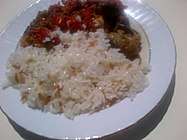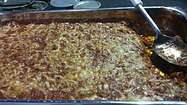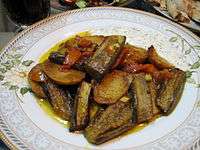Moussaka
Moussaka (/muːˈsɑːkə/, /ˌmuːsəˈkɑː/ or /ˌmuːsɑːˈkɑː/) is an eggplant- (aubergine) or potato-based dish, often including ground meat, in the Levant, Middle East, Greece, and Balkans, with many local and regional variations.
A dish of Greek moussaka | |
| Course | Main course |
|---|---|
| Place of origin | Greece, Middle East (cooked salad form), Levant |
| Region or state | The Balkans and Eastern Mediterranean |
| Serving temperature | Hot or cold |
| Main ingredients | Eggplant and/or potatoes, minced meat |
| Variations | Multiple |
The best-known version in Europe and the Americas is the Greek variant created in the 1920s by Nikolaos Tselementes. Many versions have a top layer made of milk-based sauce thickened with egg (custard) or flour (béchamel sauce). In Greece, the dish is layered and typically served hot.
This is quite different from the versions that continue to be made in Turkey and the Middle East. In Turkey, mussaka consists of thinly sliced and fried eggplant served in a tomato-based meat sauce, warm or at room temperature. In the Arab countries, it is often eaten cold, but occasionally hot as well.
Names and etymology
The English name for moussaka was borrowed from Greek mousakás (μουσακάς) and from other Balkan languages, all borrowed from Ottoman Turkish, which in turn borrwed it from Arabic musaqqa‘a (مسقعة), literally "that which is fed liquid".[1] The word is first attested in English in 1862, written mùzàkkà.[1]
Preparation
Greece

Most versions are based primarily on sautéed aubergine (eggplant) and tomato, usually with minced meat, mostly lamb. However, the Greek version includes layers of meat and eggplant topped with a Béchamel ("white") sauce, and baked. It seems likely that the Greek moussaka has Arab origins and is related to the Levantine musakhkhan, with the word moussaka derived from this Arab word.[2]
The modern Greek version was created by the French-trained Greek chef Nikolaos Tselementes in the 1920s.[3][4] A standard Tselementes-style recipe has three layers that are separately cooked before being combined for the final baking: a bottom layer of sliced eggplant sautéed in olive oil; a middle layer of ground lamb lightly cooked with chopped or puréed tomatoes, onion, garlic, and spices (cinnamon, allspice and black pepper); and a top layer of Béchamel sauce or savoury custard. The composed dish is then layered into a pan and baked until the top layer is browned. Moussaka is usually served warm, not hot; if cut hot out of the oven, moussaka squares tend to slide apart and consequently the dish needs some resting time to firm up before serving. Reheating, however, does not present the same problem.
There are variations on this basic recipe, sometimes with no top sauce, sometimes with other vegetables. Such variants may include, in addition to the eggplant slices, sautéed zucchini (courgette) slices, part-fried potato slices, or sautéed mushrooms. There is a fast-day (vegan) version in Tselementes' cookbook, which includes neither meat nor dairy products, just vegetables (ground eggplant is used instead of ground meat), tomato sauce, and bread crumbs.
Another variant is (melitzanes) papoutsakia (μελιτζάνες) παπουτσάκια (lit. "eggplant, little shoe style") which consists of whole small eggplant stuffed with ground meat and topped with béchamel and baked.
Levant
In the Levant, moussaka is a cooked dish made up primarily of tomatoes and eggplant, similar to Sicilian caponata, and may also include chickpeas. It may be served cold as a mezze dish, or hot.
Egypt
The Egyptian version of moussaka is made from layers of fried eggplant immersed in tomato sauce and then baked. A layer of seasoned cooked ground beef is usually added between the eggplant before baking. The dish can be served hot but is usually chilled for a day or so to improve the taste.
Turkey


Turkish musakka is not layered.[5] Instead, thinly sliced eggplant is fried and served in tomato-based meat sauce seasoned with green peppers, garlic and onions.[6] It is generally eaten with pilav and cacık. There are also variants with zucchini (kabak musakka), carrots (havuç musakka) and potatoes (patates musakka).
Former Yugoslavia, Bulgaria, Romania and Albania
In Albania,[7] Bulgaria,[8] the former Yugoslavia,[9][10][11] and Romania, potatoes are used instead of eggplant, pork or beef mince, and the top layer is usually milk or yogurt mixed with raw eggs, sometimes with a small amount of flour added. There is also a three-layer version: the bottom layer consists of ground pork and beef, the middle layer of potato slices, and the top layer is typically a custard. Each layer is cooked on its own and layered in a pan and baked until the top is browned.
The Romanian version is made usually with potatoes or eggplant or cabbage. The layers start with the vegetable, then the layer of meat (usually pork), then vegetables, until the pot is full. Sometimes bread crumbs are used for toppings, sometimes slices of tomatoes and crushed cheese. The pot is then filled with tomato sauce. There is also a pasta variant, with pasta being used instead of vegetables. The "fasting" variant, which is vegan, replaces meat with mushrooms or a mix of sautéed onions and rice.
In the rest of the Balkans, the top layer is often a custard: this is the version introduced in the UK by Elizabeth David's Mediterranean Cookery and where it remains the usual presentation. Grated cheese or bread crumbs are often sprinkled on top.
See also
- List of casserole dishes
- Karnıyarık – recipe comparable to moussaka, popular in Turkey
- Pastitsio – Greek baked pasta dish
- Shepherd's pie – recipe comparable to moussaka, popular in the United Kingdom
- Tepsi Baytinijan – recipe comparable to moussaka, popular in Iraq
References
- Oxford English Dictionary 3rd ed., March 2003 s.v. (subscription)
- "Did You Know: Food History – Is This the First Moussaka?". www.cliffordawright.com.
- Aglaia Kremezi, "Nikolas Tselementes", Cooks and Other People, Proceedings of the Oxford Symposium on Food and Cookery, p. 167: "before Tselementes there was no moussaka, as we know it today"
- Kremezi, Aglaia (13 July 2010). "'Classic' Greek Cuisine: Not So Classic". The Atlantic. Archived from the original on 16 February 2012. Retrieved 10 March 2017.
- Ken Albala (2011). Food Cultures of the World Encyclopedia. ABC-CLIO. pp. 307–. ISBN 978-0-313-37626-9.
- "Patlıcan musakka tarifi (Musakka nasıl yapılır?)". MİLLİYET HABER – TÜRKİYE'NİN HABER SİTESİ. Retrieved 2018-04-24.
- Mark Zanger (January 2001). The American Ethnic Cookbook for Students. ABC-CLIO. p. 9. ISBN 978-1-57356-345-1.
- Leslie Strnadel; Patrick Erdley (January 2012). Bulgaria (Other Places Travel Guide). Other Places Publishing. p. 55. ISBN 978-0-9822619-9-6.
- The Balkan Cookbook. Pelican Publishing Company. p. 121. ISBN 978-1-4556-0057-1.
- Liliana Pavicic; Gordana Pirker-Mosher (1 January 2007). Best of Croatian Cooking. Hippocrene Books. p. 132. ISBN 978-0-7818-1203-0.
- Avani Burdett. Delicatessen Cookbook – Burdett's Delicatessen Recipes: How to make and sell Continental & World Cuisine foods. Springwood emedia. p. 113. ISBN 978-1-4761-4462-7.
External links

